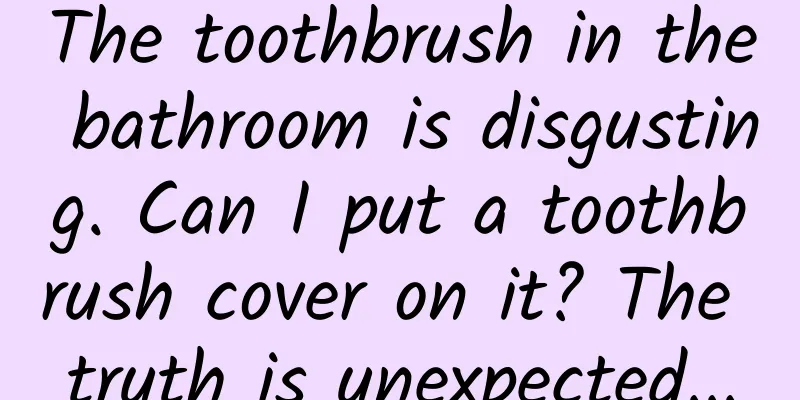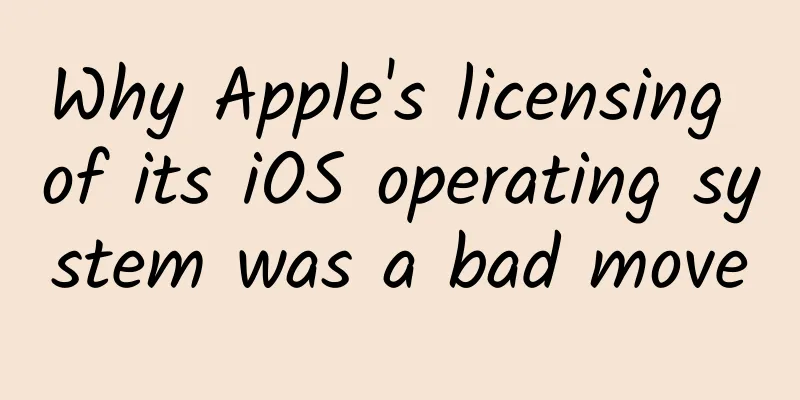The toothbrush in the bathroom is disgusting. Can I put a toothbrush cover on it? The truth is unexpected...

|
After defecation, flush the toilet. The water and air flow flush the bacteria in the toilet into the air, landing on the toilet seat, towels, and... the toothbrush that you put in your mouth every day. This scene is disgusting just thinking about it, so toothbrush covers came into being. Many people are accustomed to covering the toothbrush head to prevent outside bacteria from falling on it, but is this really more hygienic? E-commerce platform screenshots How dirty is a “naked” toothbrush? A toothbrush has many bristles, but there are more types of microorganisms on it than the bristles. 1 If your home is clean The main bacteria on used toothbrushes are Enterobacteriaceae, Micrococcaceae, Actinomycetaceae and Streptococcaceae. The longer the toothbrush is used, the more bacteria there are . It is not very realistic to use antibacterial toothbrushes to inhibit bacterial growth on the bristles. Antibacterial materials may work well in a constant temperature and humidity laboratory environment, but it is hard to say if you use them at home. After all, the temperature, humidity, pH and other conditions will vary, which may affect the antibacterial effect. In short, antibacterial toothbrushes have a certain effect, but don't rely on them. Fortunately, these bacteria are nothing to be afraid of . After all, we have only heard of dental diseases caused by not brushing teeth, but we have never heard of brushing teeth causing illness, right? These types of bacteria basically come from the human mouth and are the "natives" in your mouth, that is, part of the normal flora. If you don't worry about getting sick from swallowing saliva, then you don't have to worry about these bacteria on your toothbrush causing illness. In addition, generally speaking, the more bacteria there are, the stronger their ability to cause disease. However , toothbrushes need to be cleaned at least twice a day, so the number of bacteria on the bristles will not be particularly high, and the possibility of causing disease is also smaller. 2 If your house is dirty But if the hygiene of the place where you wash your mouth is poor or your oral hygiene is poor, it’s a different story. As early as 100 years ago, people were aware of the problem of toothbrush contamination. Harmful bacteria during oral infection, bacteria on the hands holding the toothbrush, and bacteria in the aerosols produced when flushing the toilet can all contaminate toothbrushes, allowing "outsider" bacteria to set up camp on toothbrushes. If bathroom hygiene and oral hygiene are not good, the majority of bacteria on toothbrushes may not be "natives" but "outsiders". These "outsiders" are not very pathogenic, and the presence of pathogenic bacteria does not necessarily lead to disease, but this does pose a small hidden danger to our health, and even shocks us in our hearts, and makes us a little nauseous. Therefore, it is best to replace your toothbrush every 3 months to get rid of hidden bacteria. Moreover, after 3 months of use, the bristles of the toothbrush will have worn or even deformed, and will not achieve a good cleaning effect. Screenshots of various toothbrush set e-commerce platforms Is it better to put a cover on your toothbrush? Many people mind toothbrushes being too close to toilets and drains, so toothbrush covers were invented. Does covering the toothbrush head make it cleaner? There is a small study that you can refer to. In 2007, researchers recruited 10 college students with good oral health who all lived in dormitories and gave them new toothbrushes. In the first week, after brushing their teeth, the college students placed their toothbrushes in an open environment and waited for them to dry naturally; In the second week, the college students put a plastic brush head cover on their toothbrush after brushing their teeth. After the experiment, the researchers carefully washed the bacteria off the toothbrushes for culture, and then compared them with new toothbrushes of the same model and batch. Guess what happened? Compared with the common "indigenous bacteria" on toothbrushes mentioned above and new toothbrushes used as controls, these toothbrushes overgrew some microorganisms , such as Pseudomonas aeruginosa, gram-negative aerobes and opportunistic pathogens. Among them, Pseudomonas aeruginosa is one of the main pathogens that cause pneumonia, soft tissue infection, urinary tract infection and even sepsis. It is a relatively ferocious pathogen. If the user's oral mucosa is damaged or the immune system is low, using such a toothbrush may cause health problems. The reason is not difficult to understand. Although the toothbrush cover can isolate some foreign bacteria and dust, on the one hand, it has no bactericidal effect after all, and the bacteria from the environment or mouth that are already on the toothbrush still exist ; on the other hand, the toothbrush cover hinders the evaporation of water, and the humid environment provides a good environment for bacterial growth. Do I need to wear a cover on my toothbrush? Finally, let’s summarize. "Naked" toothbrush: 1. Bacteria mainly come from normal oral flora. A bad environment and poor oral hygiene will increase the number of pathogenic bacteria; 2. Mainly bacteria with weak pathogenicity; Toothbrush with cover: 1. The source of bacteria is basically the same as that of "naked release"; 2. Suitable for bacterial growth, the number of highly pathogenic bacteria increases significantly. In general, after using the toothbrush, shake it dry as much as possible and put it in a clean place. Using a toothbrush cover is superfluous . If you need to take a toothbrush with you when you go on a long trip, it is best to fully dry the toothbrush before putting it in the toothbrush cover. References [1]Zinn MK, Schages L, Bockmühl D. The Toothbrush Microbiome: Impact of User Age, Period of Use and Bristle Material on the Microbial Communities of Toothbrushes. Microorganisms. 2020;8(9):1379. [2] Caudry SD, Klitorinos A, Chan EC. Contaminated toothbrushes and their disinfection. J Can Dent Assoc. 1995;61(6):511-516. [3]Mehta A, Sequeira PS, Bhat G. Bacterial contamination and decontamination of toothbrushes after use. NY State Dent J. 2007;73(3):20-22. Planning and production Source: Guokr (ID: Guokr42) Author: Li Meng, Clinical Microbiologist at the First Affiliated Hospital of Guangxi Medical University Review丨Zhang Yu, researcher at the Chinese Center for Disease Control and Prevention, national health science expert Shi Xiaojun, deputy chief physician, Shanghai Fifth People's Hospital Editor: Zhong Yanping Proofread by Xu Lailinlin |
Recommend
Apple Watch 2's new system is a tragedy that directly bricks it
Apple recently pushed a new system, watchOS 3.1.1...
How to quickly pass the self-media platform review? How to apply for a self-media platform to pass faster?
The hottest and most popular thing now is self-me...
A fast integration framework: MVP+Dagger+mainstream framework, it is enough
Preface In the Android technology circle this yea...
Kuaishou launches new strategy for placing information flow ads
Recently, many optimizer friends have consulted a...
Kuaishou brand account operation plan!
2021 is the first year of brand self-broadcasting...
Decisive Collection丨Summary of arrangements for the National Day holiday in some Android app markets
The National Day and Mid-Autumn Festival are appr...
What happens to old trees? The oldest tree is over 5,000 years old. Why is it so long-lived?
Currently, the oldest known tree in the world is ...
New vulnerability: One song can compromise all Android devices
Security researchers at Zimperium zLabs have disc...
After 10 years of research, large-scale breeding is achieved! What is the garlic orchid and is it edible?
After 10 years of research, this national second-...
How to obtain information sources for bidding promotion?
We all know that all revenue-generating categorie...
How much does it cost to attract investment in the Haikou children’s clothing mini program? What is the investment quotation for the Haikou children's clothing mini program?
How much does it cost to invest in the Haikou chi...
Zheng Duoyan's 6-week aerobics weight loss plan
Zheng Duoyan's 6-week aerobics weight loss pl...
Why do my eyes hurt after wearing my new glasses for a while? I never thought of this reason
Regarding glasses, I often see people encounterin...
“Double 11” war has begun. What new tricks will Alibaba use to empty your wallet?
On October 20, the "2018 Double 11 Global Ca...
How much does it cost to customize the Heihe course mini program? What is the price for customizing the Heihe Course mini program?
There are two types of customization of Heihe Cou...









